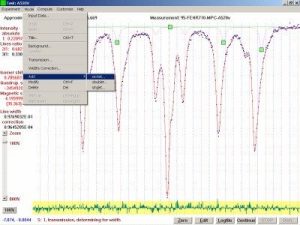Software CONFIT2000 version 4.12.39 (new): Mössbauer spectra fitting
This application allows a complex treatment of Mössbauer spectra starting from a setting of the background and of the individual components according to the selected model by the mouse drag-and-drop technique. It is designed for the spectroscopy of 57Fe and 119Sn isotopes with nuclear spin values of 1/2 and 3/2. An original method has been applied combining a non-linear least-squares procedure with the Fast Fourier Transform technique. An improved matrix formalism allows one to construct nearly all imaginable physical models of Mössbauer spectra supported by a computer-aided matrix model design. It is possible to introduce not only hyperfine magnetic field distributions, but now also doublets quadrupole splitting distribution with a Gaussian profile. In the connection with the distribution it is always supposed that the quadrupole interaction is much weaker than the magnetic one. When the final thickness of the sample has to be considered, the transmission integral calculation can be established. A special parameter can be introduced that characterises the increase in the width of all spectra lines in dependence on their distance from the spectrum middle (on the absolute velocity). The fitted spectra can be taken in the transmission or back-scattering (conversion electrons) geometry. The fitting process is very fast also for complicated spectra.
Last update: June 10, 2020
Overview of main features:
- World's first Mössbauer program utilizing the convolution algorithm in the fitting of overlapped Mössbauer spectra
- Mössbauer program integrating the fitting of crystalline and amorphous (distribution) models in a single fit menu system
- World's first Mössbauer program with full Windows XP/Vista/W7/W8/W10 support in which the setting of the model components is fully mouse-oriented with immediate possibility of modification
- World's first Mössbauer program that can be opened in an application window of at least 800 x 600 pixel and run contemporary with other applications
- Easy modification of the model for other spectra of the same kind
- Immediate clipboard and printing functions and/or output to standard files for graphs and spreadsheets (also for subspectra and their arbitrary sum)
- Able to fit different distributions together with discrete subspectra of crystalline sites
- Transmission and back-scattering (conversion) modes
- Thin absorber approximation: transmission Integral calculation for a convolution of Lorentzian with Gaussian component
- Possibility of adding and subtracting of spectra
- Able to calibrate and fit unfolded spectra as well as folded ones
- Isotopes: 57Fe and 119Sn
- Correction factor for velocity dependent line-widths
- Enhanced component editing and possibility to change the sequence of individual components in the list of sextets, doublets or singlets
- RTF report file containing final values of component characteristics together with their summary and a figure with a final spectrum fit
- Compressed BMP file containing simple figure with a final fit of the spectrum
- Also older parameter files from the processing history can be used for opening the fitting process
- Individual sextets can have their own intensity ratios of inner to outer lines according to the nature of magnetic ordering of individual components
- The scale of the spectrum effect axis can be extended or shrunken making easier to set-up models with combination of components having large intensity difference or poor statistics
- Each parameter value can be completed with lower and/or upper boundary, limiting the changes of the respective fitted parameter
- Easier treatment of calibration spectra, both sodium nitroprusside and metallic iron (2, 4, or 6 lines)
- The WEB binary format as used by the WMOSS software was included into the input capabilities
- The Demo version is no more restricted to the single component and allows introducing of the same combination of various components as the full version
- The background level can be changed using the mouse drag, similarly to the individual components
- The WIS and WS5 text formats as used by the software of the firm “WissEl” were included into the input capabilities
- It is possible to set the line width also using the mouse dragging after clicking on the line peak
- The possibility of automated correction of dropped points was introduced
- The Help system was changed from "WinHelp" to "HTMLHelp", acceptable also for Windows Vista and newer
- Summary tables as a new approach to the management of components linking
- Grouping of components allows to divide spectrum into subspectra of individual phases, e.g.
- Arbitrary zooming of the spectrum graph
- Combination of spectra with velocity axis is possible (in case of the same scaling)
- Enhanced treating of doublet spectra; better models of asymmetrical components
- The maximal number of experimental points was expanded to 2048
- Much easier work with components having parameters depending on or identical with a leading component
- Changing between components via the mouse wheel
- Series of measurements having the same model and also some common parameters can be fitted simultaneously now
- The maximal number of parameters (without background ones) was expanded to 200
- The maximal numbers of components of respective types are 99 now
Actual basic parameters limits (can be changed upon request)
maximal number of experimental points: 2048 maximal number of all parameters: 205 maximal number of all components: 200 number of submatrices: 4 number of distribution submatrices: 1Price: Now $ 899 only
Try the latest demo version! Now!
30 days trial version will be sent on request
The demo program mirrors the most actual full version 4.12.39. Maybe, your yesterday suggestions are already realized! Send any questions, comments and orders to: Dr. Tomáš Žák (zak@ipm.cz)



